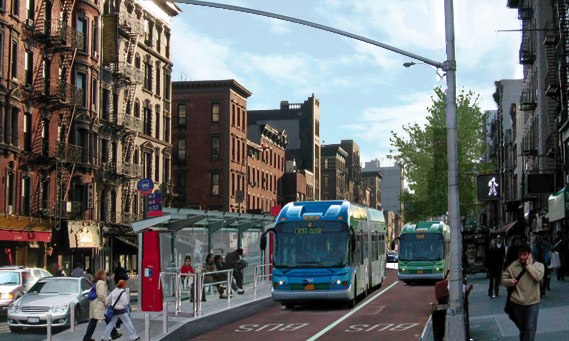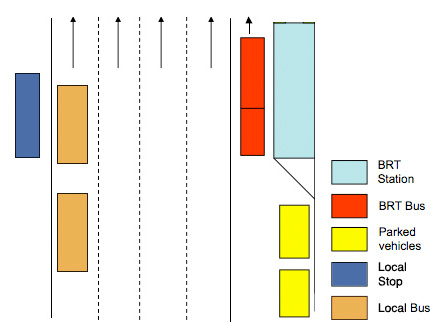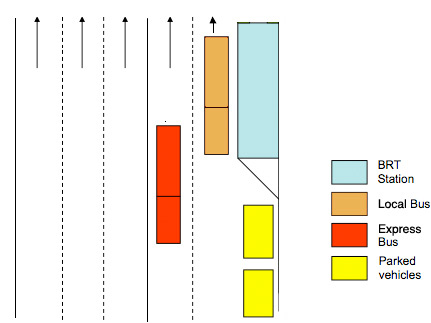BRT and New York City, Part 4: Getting It Right
 What BRT might look like on First or Second Avenue. Photosim by Carly Clark/Livable Streets Initiative.
What BRT might look like on First or Second Avenue. Photosim by Carly Clark/Livable Streets Initiative.We conclude our discussion with ITDP director Walter Hook with a look at potential BRT configurations. In yesterday’s installment, Hook noted that the best BRT systems incorporate both local and express services within exclusive busways, which requires three lanes at station stops. Here he discusses how to make this work along First and Second Avenue in Manhattan.
Streetsblog: What are the options for configuring BRT on First and Second Avenue? If a three-lane configuration is not politically feasible, what else might we end up with?
Walter Hook: It would take a lot of political courage to take three lanes out of First
and Second Avenue exclusively for buses, but the current plan, de facto,
also takes three lanes at the station stops (see diagram after the jump). I don’t think anything has been finalized, so perhaps we will get a great design even on First and Second Avenue. It would take some political heavy lifting to turn them into New York’s first ‘real’ BRT corridor. The folks at NYCDOT and the MTA know what they are doing, they are pretty familiar with the Latin American BRT systems, and there is no exact precedent for First and Second Avenue, so it would take some real creativity to pull it off.
The initial thinking, I believe, has been to allow only limited stop services inside a bus lane designated primarily with paint. The busway road configuration would probably look something like Broadway south of Houston Street, with a new nice bus shelter built on what used to be several parking spaces (a bus bulb), but with pre-paid ticketing like on Fordham Road:

I don’t see any major obstacle to making this shelter an elevated, fully enclosed pre-paid boarding station with security personnel and a high standard of architectural design, and maybe they are considering this. This would add speed and style. They could then go with a quality, high floor, multi-door articulated BRT bus, the standard BRT vehicle built by Skania, Volvo, and Mercedes.
Parking would probably be retained where there is no bus stop, so vehicles wishing to park will still need to cross the bus lane. Since there can be no physical segregation if the parking remains, the lane will inevitably still face problems with double-parked taxis and police cars. Ideally they can also have enforcement cameras mounted on the bus, like in London, which would take care of taxi violators but appears to be illegal for enforcement of normal traffic, and won’t do anything about double-parked cops. Local bus services, which constitute nearly half of the bus passengers along First and Second Avenue, will probably continue to operate as before, in mixed traffic lanes, stopping at traditional shelters on the other side of the street, getting no benefit from the bus lane. This has two potentially adverse impacts. First, it means that the impact on mixed traffic will be worse. If you take out one lane for bus-only, and you leave the local buses in another lane, you effectively lose two lanes to buses anyway, and you lose the parking at the stations, so it also effectively consumes three lanes but it is not as visible.
A slightly preferable option would be the following:

In this case, the express and the local buses would both benefit from the exclusivity of the busway, and from the time savings of pre-paid boarding stations. It would also remove the adverse impact of the local buses stopping in mixed traffic. The down side is that it requires two exclusive bus lanes, and the parking lane, and it requires the construction of a lot more pre-paid boarding stations, more personnel to man them, and more costs as a result.
There is a final possibility, which I think I prefer:

In this case, the parking serves to protect the exclusivity of the busway, just like the new parking protected bike lanes on Grand Street and on Ninth Avenue. Left turns would be prohibited across the busway, (or right turns if the busway were run down the other side of the street) but vehicles wishing to turn left will just have to make three right turns, something not so difficult in a thick grid like in Manhattan. Alternatively, left turns could be allowed, but this would necessitate a separate signal phase.
The configuration above allows both express buses and local buses to use the exclusive busway. It would be able to handle very high volumes, probably enough to handle Second Avenue Subway-level volumes. It is quite similar to something we proposed in the Johannesburg Rea Vaya BRT program in the CBD. They ultimately put the two-lane busway and the four meter-wide station in the middle of a five-lane road, something more radical than what we proposed.
SB: Are there certain crossings that lend themselves to interborough BRT connections — the Manhattan Bridge or the Queens Midtown Tunnel, for instance? Could BRT be a way to bring transit services to underserved areas in the Bronx, eastern Queens, and southern Brooklyn that currently have poor transit access?
WH: The Fordham Road corridor in the Bronx crosses into Northern Manhattan and connects to the subway, and there are interborough express buses using the Gowanus HOV lane and the Brooklyn Battery Tunnel, obviously without intermediate stops. BRT could be used for interborough crossings when there is demand for a high speed interborough service and there is no subway service with available capacity. There is a lot of subway service over the Manhattan Bridge. There is a big problem getting in from Williamsburg. I think there are some good corridors in the outer boroughs. But we need to be careful at first that people don’t associate BRT with low demand, secondary corridors in poor neighborhoods in the outer boroughs. In the early phases, we need to get a BRT that proves what BRT can be, so before the general concept is accepted, we need something pretty high-profile that everyone will see, something the New York Times reporters and WNYC reporters will ride on their way to work. Something radical along the Brooklyn waterfront might be interesting.
SB: What are the risks in planning and implementing the system here? What could go wrong and what are some common pitfalls?
WH: BRT is easiest to put in where you already have a lot of bus traffic. If you put buses in a dedicated bus lane, and the bus frequency is high, like more than one per minute, it is a lot easier than putting a bus lane on a road where there is only one bus every 10 or 20 minutes. People get pretty upset looking at that empty bus lane, and they should. If you have low bus frequency, you might as well open the lane to high occupancy vehicles, or motorists willing to pay a toll, or taxis, or even bicyclists or motorcycles in some conditions. New York has a few pretty high bus frequency corridors where BRT would work, but it’s not going to work everywhere.
SB: Four years from now, how will we know whether New York got BRT right?
WH: You’ll know because it will be on the tourist map, and everybody will know about it and complain about it, because it will be as much a part of everyday life as the subway.
SB: What would New York have to do in 2009 to win the Sustainable Transport Award again?
WH: A world-class interborough BRT, full pedestrianization of Broadway at least between Times Square and Union Square (we did this Q&A before yesterday’s announcement — eds.), some model shared streets, new model parking rules, and a world-class bike sharing program. Hey, the bar is getting raised every year. Besides, there is no way we would give it to the same city two years in a row no matter what miracles they accomplished, so they should think big, and aim for 2011 or 2012. Bloomberg will probably have plenty of time, but there is a lot of competition out there. The world is changing fast.